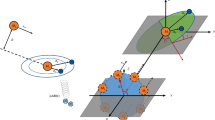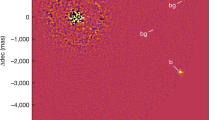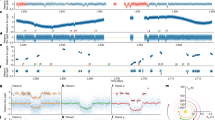Abstract
Planetary formation theories1,2 suggest that the giant planets formed on circular and coplanar orbits. The eccentricities of Jupiter, Saturn and Uranus, however, reach values of 6 per cent, 9 per cent and 8 per cent, respectively. In addition, the inclinations of the orbital planes of Saturn, Uranus and Neptune take maximum values of ∼2 degrees with respect to the mean orbital plane of Jupiter. Existing models for the excitation of the eccentricity of extrasolar giant planets3,4,5 have not been successfully applied to the Solar System. Here we show that a planetary system with initial quasi-circular, coplanar orbits would have evolved to the current orbital configuration, provided that Jupiter and Saturn crossed their 1:2 orbital resonance. We show that this resonance crossing could have occurred as the giant planets migrated owing to their interaction with a disk of planetesimals6,7. Our model reproduces all the important characteristics of the giant planets' orbits, namely their final semimajor axes, eccentricities and mutual inclinations.
This is a preview of subscription content, access via your institution
Access options
Subscribe to this journal
Receive 51 print issues and online access
$199.00 per year
only $3.90 per issue
Buy this article
- Purchase on SpringerLink
- Instant access to full article PDF
Prices may be subject to local taxes which are calculated during checkout


Similar content being viewed by others
References
Pollack, J. B. et al. Formation of the giant planets by concurrent accretion of solids and gas. Icarus 164, 62–85 (1996)
Lubow, S. H., Seibert, M. & Artymowicz, P. Disk accretion onto high-mass planets. Astrophys. J. 526, 1001–1012 (1999)
Goldreich, P. & Sari, R. Eccentricity evolution for planets in gaseous disks. Astrophys. J. 585, 1024–1037 (2003)
Papaloizou, J. C. B., Nelson, R. P. & Masset, F. Orbital eccentricity growth through disk-companion tidal interaction. Astron. Astrophys. 366, 263–275 (2001)
Zakamska, N. L. & Tremaine, S. Excitation and propagation of eccentricity disturbances in planetary systems. Astron. J. 128, 869–877 (2004)
Fernandez, J. A. & Ip, W.-H. Some dynamical aspects of the accretion of Uranus and Neptune—The exchange of orbital angular momentum with planetesimals. Icarus 58, 109–120 (1984)
Malhotra, R. The origin of Pluto's orbit: implications for the Solar System beyond Neptune. Astron. J. 110, 420–432 (1995)
Hahn, J. M. & Malhotra, R. Orbital evolution of planets embedded in a planetesimal disk. Astron. J. 117, 3041–3053 (1999)
Gomes, R. The origin of the Kuiper Belt high-inclination population. Icarus 161, 404–418 (2003)
Levison, H. F. & Morbidelli, A. The formation of the Kuiper belt by the outward transport of bodies during Neptune's migration. Nature 426, 419–421 (2003)
Gomes, R. S., Morbidelli, A. & Levison, H. F. Planetary migration in a planetesimal disk: Why did Neptune stop at 30 AU? Icarus 170, 492–507 (2004)
Kokubo, E. & Ida, S. Orbital evolution of protoplanets embedded in a swarm of planetesimals. Icarus 114, 247–257 (1995)
Duncan, M. J., Levison, H. F. & Lee, M. H. A multiple time step symplectic algorithm for integrating close encounters. Astron. J. 116, 2067–2077 (1998)
Chambers, J. E. A hybrid symplectic integrator that permits close encounters between massive bodies. Mon. Not. R. Astron. Soc. 304, 793–799 (1999)
Murray, C. & Dermott, S. F. Solar System Dynamics (Cambridge Univ. Press, Cambridge, UK, 1999)
Stern, S. A. On the number of planets in the outer solar system—Evidence of a substantial population of 1000-km bodies. Icarus 90, 271–281 (1991)
Morbidelli, A., Levison, H. F., Tsiganis, K. & Gomes, R. Chaotic capture of Jupiter's Trojan asteroids in the early Solar System. Nature doi:10.1038/nature03540 (this issue)
Gomes, R., Tsiganis, K., Morbidelli, A. & Levison, H. F. Origin of the cataclysmic Late Heavy Bombardment period of the terrestrial planets. Nature doi:10.1038/nature03676 (this issue)
Acknowledgements
R.G. is grateful to the Conselho Nacional de Desenvolvimento Científico e Tecnológico for financial support of his sabbatical year in the OCA observatory in Nice. The work of K.T. was supported by an EC Marie Curie Individual Fellowship. A.M. and H.F.L. thank the CNRS and the NSF for funding the collaboration between the OCA and the SwRI groups. H.F.L. is grateful to NASA's Origins and PG&G programmes.
Author information
Authors and Affiliations
Corresponding author
Ethics declarations
Competing interests
Reprints and permissions information is available at npg.nature.com/reprintsandpermissions. The authors declare no competing financial interests.
Supplementary information
Supplementary Discussion
A detailed illustration of the 1:2 MMR crossing of Jupiter and Saturn. This file also includes Supplementary Figure S1. (PDF 1509 kb)
Rights and permissions
About this article
Cite this article
Tsiganis, K., Gomes, R., Morbidelli, A. et al. Origin of the orbital architecture of the giant planets of the Solar System. Nature 435, 459–461 (2005). https://doi.org/10.1038/nature03539
Received:
Accepted:
Issue Date:
DOI: https://doi.org/10.1038/nature03539
This article is cited by
-
Long-Term Evolution of the Saturnian System
Space Science Reviews (2024)
-
Surface Compositions of Trojan Asteroids
Space Science Reviews (2024)
-
An overview and perspective of identifying lunar craters
Science China Earth Sciences (2024)
-
Late accretion of Ceres-like asteroids and their implantation into the outer main belt
Nature Astronomy (2023)
-
Synthesis of prebiotic organics from CO2 by catalysis with meteoritic and volcanic particles
Scientific Reports (2023)




